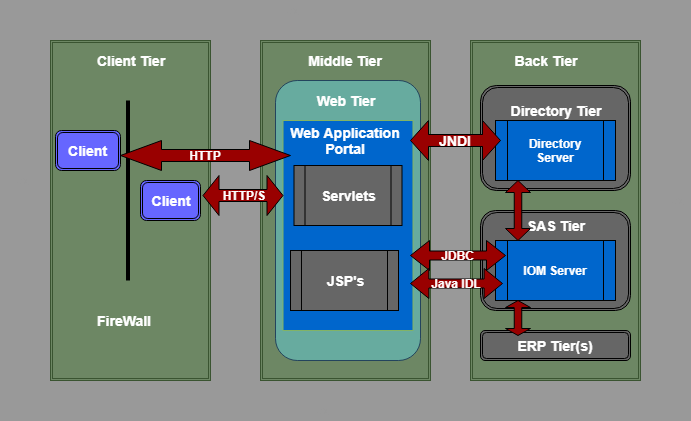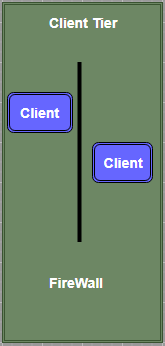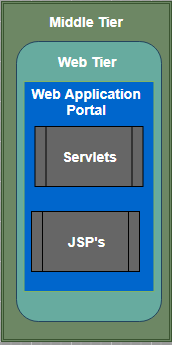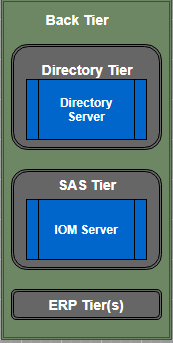SAS Intelligence Platform Architecture
SAS Intelligence Platform Architecture is designed to access large numbers of data efficiently, as well as provides timely intelligence to a great number of users simultaneously.
The platform follows a three-tier architecture that enables you to distribute functionality in computer resources so that each type of work can be done by those resources that are most suitable for the job.
You can easily examine the architecture to determine whether it meets the demands of your workload or not. For a large company, tiers can be installed in several machines with different operating systems, and for demonstrations, prototyping or very small enterprises, all the tires can be installed on a single machine.
As shown in the following SAS Architecture Diagram, the SAS Information Delivery Portal is implemented using a three-tier architecture. This architecture has proved to be highly effective for developing and deploying enterprise applications.

Architecture Components of SAS software are listed below.
Client Tier
The client tier is used to view the portal and its content. It includes all the components that are used to view the portal and content. The client tier includes a web browser that is used to interact with the portal over HTTP (HyperText Transfer Protocol) OR HTTP/S (HyperText Transmission Protocol, Secure). These HTTP or HTTP/S protocols makes the SAS Information Delivery Portal “firewall friendly.” The portal can be deployed anywhere on the network and users can access it from any internet connectivity like corporate intranet, extranet, or public internet.
Depending on the content, the client can also use one or more standard desktop applications such as Adobe Acrobat Reader or Microsoft Excel. These applications are used in the process of view content. The content is streamed by the servlets in the middle tier of the portal.
When the web browser receives such content that it does not know how to present it, it looks at the mime-type of content and tries to find a viewer that knows how to display it. Standard Web browser functionality redirects the stream of content to the appropriate viewer for displaying. Once the content comes under one of these applications, the user can process it locally or save it to disk.
There is also another optional client application that is the SAS Package Reader. SAS Package Reader is part of the SAS Publishing Framework. The Package Reader enables the user to view and manage the contents of a SAS package off-line, independent of the portal Web application.

Middle Tier
The middle tier is a center of SAS architecture which provides a centralized access point for enterprise information. All direct access to content is processed by the components that are operating in this tier. This design point offers several advantages.
By separating business logic from display logic, you can use different clients to take advantage of logic at the middle tier. One more advantage is that the centralized point of access makes it easy to implement security rules, administer the portal and manage code changes.
The following functions are hosted by the middle tier:

Web Tier
The first part of the middle tier is the web tier that contain Web Application Portal for SAS Information Delivery.
Web Application Portal
SAS Information Delivery Portal is a collection of web applications, Java Servlets, JSP, JavaBinx and other sections and resources. These components work together to access the information stored in the Enterprise Directory and present a customizable interface for the user.
Servlet container
The servlet container or servlet engine is responsible for the management of the SAS Information Distribution Portal web application. Servlet Container or engine provides a runtime environment that supports deployment, concurrency, life-cycle management, and other services for Java components.
Web server
The web server provides services for the servlet engine. For example, the servlet engine depends on the HTTP server so that it can provide HTTP message handling. Web servers can also be used to host web sites that can be accessed through the portal.
Back Tier
The back tier is the third and last part of SAS architecture. This tier provides run time environment to Data Servers and Compute Servers. A compute server can also have business objects. For example, SAS IOM servers contain SAS stored processes that analyze the data and summarize the results. As shown in the above figure, the SAS Information Delivery Portal uses standard interfaces like JDBC and Java IDL to communicate and access data from IOM servers.
Back tier contains two servers one is IOM Server that we have explained above, and another is the Enterprise Directory Server. According to the description of the Single Access Point for Enterprise Information, the Enterprise Directory Server stores metadata about the content that is located in the entire enterprise. The directory does not have content, and it contains only metadata that describes it. It contains the location of the information and how to access it, and how it relates to other content items. Web application portal uses JNDI (Java Naming and Directory Interface) to access the enterprise directory server.

Back Tier does not necessarily translate into additional hardware platforms. For small implementation, these servers can run on a machine similar to a web server. On the other hand, a large enterprise can have many compute and data servers and can be an enterprise directory that is distributed on many platforms. The architecture of the SAS Information Delivery Portal gives you the flexibility to distribute these functions as per the need.
